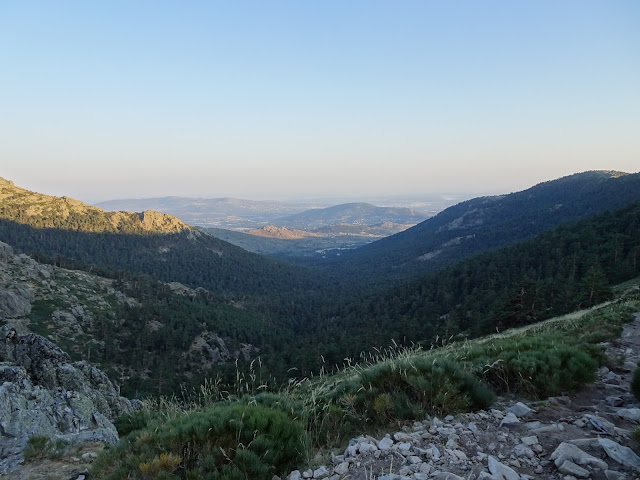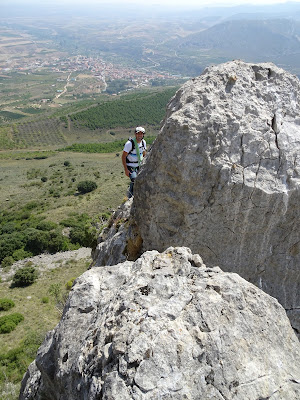Track Description / Características de la Ruta:
Distance / Distancia: 11.5km
Elevation Gain / Ascenso: 561m
Max / Min Altitude: 1866m / 1302m
Difficulty / Dificultad: Easy / Fácil
Alpine Grade: S.D. (Sin dificultad)
Activity: Hiking / Senderismo
Recommended Cartography / Cartografía Recomendada: Sierra de Guadarrama - Editorial Alpina.
Barranca Valley is a small and narrow valley close to the village of Navacerrada, 50km from Madrid. Delimited by the South Face of La Bola del Mundo (Alto de las Guaramillas), the ridge of Cabrillas (Cresta de las Cabrillas) and La Maliciosa. Paths at La Barranca, although not long, are a good choice for the hot afternoons of summer, since, once the sun starts falling from the zenith, the valley is covered by shade, making it possible to hike even in the warmest days of summer. Furthermore terrain is very easy, and most of the paths are signaled very well, so, we can extend the activity until the last hours of the day with no fear of being in the darkness. // El valle de La Barranca es un pequeño y encajonado valle cercano a la localidad de Navacerrada. Delimitado por la Cara Sur de La Bola del Mundo (Alto de Las Guaramillas), La Cresta de las Cabrillas y La Maliciosa. Los senderos por La Barranca, aunque no son muy largos, son una buena opción en las cálidas tardes de verano, ya que una vez el sol comienza a bajar hacia el horizonte, el Valle se cubre de sombra, haciendo posible pasear incluso en los días más fuertes del verano. Además el terreno es fácil, y la mayoría de los senderos bien marcados, con lo que podemos extender la actividad hasta casi sin quedarnos sin luz sin mucho miedo a perdernos.
Cuco crag is the crug located halfway between Risco de Los Emburriaaderos, on Las Cabrillas ridge, and Peña Cabrita creek, right by the "Pipeline path" or "Camino de La tubería". The rock has three traditional climbing routes (from III to V+ level, see below), and a small ridge, making from it an ideal environment to learn and practice the progression on this kind of terrain. // Peña del Cuco es la Peña que se encuentra a medio camino entre El Risco de Los Emburriaderos, ya en la Cresta de Las Cabrillas, y el Arroyo de Peña Cabrita, junto al camino de la Tubería. La Peña tiene tres vías de escalada clásica (desde III a V+, ver croquis más adelante), y una pequeña cresta, haciendola un entorno ideal para practicar la progresión sobre crestas y aristas.
For a climbing sketch of Cuco's crag, visit the link below:
| Blog: http://antonio-segundatemporada.blogspot.com.es/2014/08/pena-del-cuco-navacerrada.html |
As most of the activities within Barranca Valley, the hike starts in the parking lot close to the dam Embalse del Pueblo de Navacerrada (do not confuse with Embalse de Navacerrada) and dam of Ejército del Aire. The easiest way to arrive at the parking lot is driving the M-601, at the crossroad of Cercedilla/Cerceda/Puerto Navacerrada, continue to Cerceda. After a few minutes we will find a narrow road on our left, signaled as "La Barranca". Once on the narrow road, we will drive until the end of the road, once we have passed the fire station and the abandoned hospital. // Como la mayoría de las rutas en el Valle de la Barranca, la actividad comienza en los parkings junto al embalse del Pueblo de Navacerrada (no confundir con el Embalse de Navacerrada) y el Embalse del Ejército del Aire. Existen varias alternativas para llegar a este parking, para mi la más fácil es continuar por la M-601 hasta el cruce de Cercedilla/Cerceda/Puerto Navacerrada. En dicho cruce nos vamos dirección Cerceda hasta que veamos una estrecha carretera con un cartel indicando La Barranca. Una vez en la Carretera seguimos todo recto (pasando por el parque de Bomberos y el Antiguo Hospital, ahora abandonado) hasta llegar a los dos parkings al final de la carretera.
A PR path (white and yellow painted marks) starts from the parking. After a few minutes we will pass by Fuente del Mingo (water source). A few minutes later, there is a fork on the path, the path to the East leads to Collado del Piornal, a popular path leading to Maliciosa summit. We will take the one on our left to continue heading West. // Desde el parking comienza un sendero PR (blanco y amarillo). Al poco de comenzar tenemos una fuenta a pie de Sendero, Fuente del Mingo. Un poco más arriba existe una bifurcación, el camino hacia el Este asciende hacia la Maliciosa por el Collado del Piornal, nosotros sin embargo seguiremos en la pista forestal hacia el Oeste.
Once we cross Peña de Cabra creek, a small path on our right leaves the main path and ascends in the pinetree forest. We can equally keep on the main path, which we will use for the way back, but the distance is longer. // Tras pasar el Arroyo de Peña de Cabra, un pequeño camino a nuestra derecha abandona la pista forestal y asciende entre el bosque de pinos. Igualmente podríamos haber seguido por la pista forestal, pero el camino se hace más largo en este caso.
As we ascends the pinetree forest opens, and we have privileged views of Cresta (ridge) de las Buitreras and Maliciosa. The shade is climbing up quickly through the hillsides of La Maliciosa. // Desde el camino, aprovechando los claros entre los pinos, podemos observar la Cresta de las Buitreras y los Riscos de la Maliciosa. Observamos en la foto como la sombra va asciendendo rápidamente por las Laderas de la Maliciosa.
The path ascends now on the hillsides of Cuerda de Las Cabrillas, until the pinetree forest ends. From this point we have now direct view of Peña del Cuco, Alto de las Guaramillas (Bola del Mundo) and Riscos de la Maliciosa. // El camino asciende por la ladera de la Cuerda de Las Cabrillas hasta que termina el bosque de pinos. Desde este punto ya tenemos visión directa con Peña del Cuco. También podemos ver El Alto de las Guaramillas, los Riscos de La Maliciosa.
Peña del Cuco is this big crug in the middle of the valley, an area known as Garganta del Infierno (Hell's gorge). // Peña del Cuco es este bloque de piedras que se encuentra en medio del Valle, y que baja casi hasta el Arroyo de Peña de Cabra, en la Garganta del Infierno.
This is the end of Peña del Cuco, where the ridge ends, close to the path, the climbing routes are on the opposite side of the crug. // Parte final de Peña del Cuco, donde termina la Cresta. Las vías de escalada empiezan justo en el extremo opuesto.
From this point we have a privileged view of Barranca Valley, which we just walked up. // Desde Peña del Cuco tenemos una vista perfecta de todo el Valle de La Barranca hasta Cabeza Mediana.

And the shade climbs upper and upper as the sun sets. // La sombra cada vez trepa más alto por la Cuerda de Las Buitreras.
For the way back, we take the "Pipeline path" or "Camino de la Tubería". It is easy to identify since we can see and old iron pipeline on the side of the path, I guess it was used to provide Navacerrada village with water in the old times. //Para descender tomamos el Camino de la Tubería. Se llama así porque a lo largo del mismo puede observarse una antigua tubería de hierro que antiguamente supongo abastecería al pueblo de Navacerrada.
The path ascends to Cuerda de Las Cabrillas, to the summit of Risco del Emburriadero, and then gets back to the principal path we used on our way up. From the summit of Cuerda de las Cabrillas we have views to the valley of Puerto de Navacerrada. // El camino asciende temporalmente hacia la Cuerda de Las Cuadrillas hasta el Collado del Emburriadero para luego volver a la Pista Forestal que abandonamos antes. Desde el Collado tenemos vistas hacia el Valle por el que asciende la Carretera del Puerto de Navacerrada...
and to Siete Picos summits... // así como de la zona de Siete Picos...
Orange color in La Maliciosa (this is the golden hour, as the professional photographers says), the shades has already achieved Collado del Piornal. // Colores Anaranjados (Golden Hour como dicen los entendidos de Fotografía) en la Maliciosa. La Sombra ya llega hasta el Collado del Piornal.
 |
| Collado de Los Emburriaderos, en la Cresta de Las Cabrillas. |
Once we are back on the principal path, at Mirador de Las Canchas or La Barranca (viewpoint), we descend toward Valle de La Barranca. Be careful not to descend to the other side, since you will end up at Puerto de Navacerrada road. // Una vez cogemos la pista Forestal, a la altura del Mirador de las Canchas o de La Barranca hacemos la curva de herradura y descendemos de nuevo hacia el Valle de La Barranca. Cuidado con no ir en dirección contraria ya que acabaremos en la Carretera del Puerto de Navacerrada.
It is getting dark, but the way back is easy, we have just to follow the principal path until reaching the parking lot, no chance to get lost. // La noche enseguida se echa encima, por suerte, ahora sólo queda seguir la pista forestal hasta el parking donde comenzamos la actividad, no tiene pérdida.
Summary // Resumen:
- There are a couple of water sources on the path, Fuente Mingo and La Campanilla. // Existen un par de fuentes bien señalizadas cerca del recorrido, la Fuente Mingo y la Campanilla (aunque el track no pasa por ésta última).
- Nice activity for hot summer afternoons, since the valley is in shade. // Ideal actividad para las tardes de verano, ya que el Valle enseguida se cubre de sombra.














































































